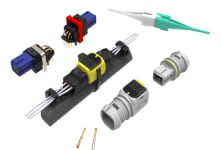Q: What is Single Pair Ethernet (SPE)?
A: Single Pair Ethernet enables the transmission of data by Ethernet using only one twisted pair.
It is currently capable of transmission rates ranging from 10Mb/s to 1Gb/s. For aerospace applications, initial release is for 100BT1, future (next) version will be for 1000BT1.
Q: What are the advantages of Single Pair Ethernet (SPE) over conventional Ethernet?
A: Conventional Ethernet which is based on industrial applications requires two or four pairs of wires. In comparison Single Pair Ethernet only has one pair. Compared to the four and eight wires in conventional Ethernet cable categories this two-wire design cuts cabling weight nearly in half. Single Pair Ethernet helps to reduce costs and system complexity. Thanks to its versatility and universally accepted open standards it supports the design of distributed network architectures in modern aircraft cabins.
Q: How can Single Pair Ethernet (SPE) be used in Commercial Aerospace?
A: As defined in the soon-to-be-released ARINC 854 Cabin Equipment Network Bus standard, initial usage for Ethernet over Single Pair for 15 meter or less will be for passenger seating and cabin lighting. As the technology progresses to 1000BTI many more aircraft application will emerge.
Q: What are the advantages of Single Pair Ethernet in Commercial Aerospace?
A: Let’s look at the example about the weight of ethernet wiring in a wide-body commercial jet. If a Mini-ETH cable/connector solution reduces Ethernet wiring weight by 50 percent, that would reduce the load by 50 kg (110 lbs). If that much weight was eliminated, then annual fuel costs would be cut by $31851 per aircraft.
1 Ethernet portion of wiring and 50 kg (110 lbs) weight reduction with Mini-ETH interconnection solution are estimates. Actual reductions will vary depending on design. Estimated fuel savings derived from formula used: Additional Fuel Consumption per Year multiped by the Average 2019 Fuel Cost (244,200 X $1.93 = $471,306 annual fuel cost.
Source of fuel cost: U.S. Kerosene-Type Jet Fuel Wholesale/Resale Price by Refiners. (U.S. Energy Information Administration), release date April 1,2020.
Q: Which standards does the Mini-ETH Single Pair Ethernet (SPE) connector apply to?
A: TE’s 369 Connector Series is based on the performance standard of EN4165/ARINC 809. It is available with 3, 6, and 9 positions using aerospace standard AS39029/EN3155 size 22 contacts.
Q: What does Mini-ETH mean?
A: Mini-ETH is an abbreviation of miniaturized Ethernet. TE’s 369 shielded connector has been down-selected by the ARINC 854 Cabin Equipment Network Standard as the enabling ethernet connector. 369 series connectors have been developed to provide a range of high reliability, lightweight, compact, and cost-efficient connectors suited to aerospace.
Q: Can power also be transmitted over Single Pair Ethernet (SPE)?
A: Power transmission has also been standardized. Power over Data Line (PoDL) is the term used to describe effective power supply of up to 50W. The ARINC 854 Cabin Equipment Network Standard is focusing on 15m maximum.
Q: What is the origin of Single Pair Ethernet (SPE) technology?
A: The development of Single Pair Ethernet began in 2011 with the Broadcom Corporation releasing its BroadR-Reach standard allowing automotive manufacturers to standardize on an open, scalable 100 Mb/s Ethernet-based network protocol. This work inspired the OPEN Alliance working group to define 100BASE-T1 as an “Automotive Ethernet” standard published as IEEE 802.3bw in 2015.
In 2019 100BASE-T1 was adopted as Ethernet Industrial Protocol (IP) in the IEEE 802.3cg standard. This standard is a common solution for the Industrial Internet of Things (IIoT).
The Aviation Cabin Systems Subcommittee organized by ARINC Industry Activities references 100BASE-T1 in their new soon-to-be-released ARINC 854 Cabin Equipment Network Bus specifications.
Q: Can Single Pair Ethernet (SPE) be transmitted over existing network cables?
A: This is known as cable sharing and involves the transmission of Single Pair Ethernet over four-pair Ethernet cable. Although there is some overlap in the performance of 4-pair vs single pair Ethernet cabling, there are some significant differences in the performance requirements that does not make it a straight swap of shielded Ethernet pairs to Single Pair Ethernet. It is theoretically possible but not practical. It should be seen as a practical addition to the Ethernet standard and as a replacement of fieldbusses.
Q: Where can I buy the Single Pair Ethernet (SPE) Connectors for Commercial Aerospace?
A: TE has a 24/7 customer service group that can assist with your needs, or complete the “Connect With Us” form and one of our representatives will contact you within 48 hours.
 e
e
 e
e
 e
e
